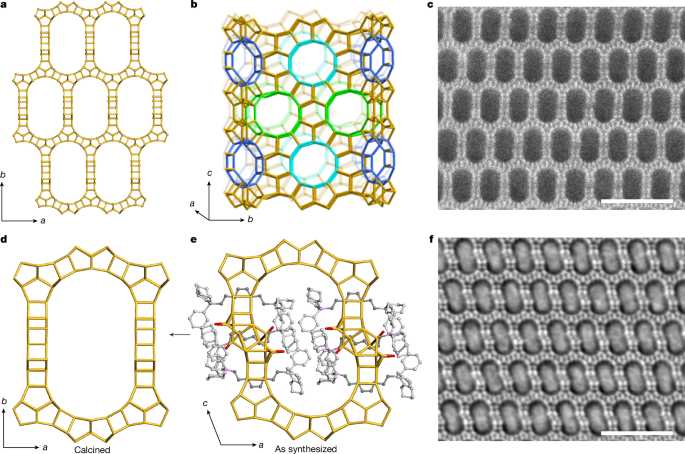一种具有原子有序互联介孔通道的稳定沸石
IF 48.5
1区 综合性期刊
Q1 MULTIDISCIPLINARY SCIENCES
引用次数: 0
摘要
沸石是由四面体(SiO4和AlO4)组成的晶体微孔材料,作为离子交换剂、吸附剂和多相催化剂在工业上有许多应用。然而,微孔的存在阻碍了沸石在处理大块底物领域的使用。在沸石中引入外部介孔,即晶间/晶内介孔,是克服扩散势垒5,6,7,8的一种解决方案。然而,这些外在介孔通常是无序和不均匀的;此外,酸度和结晶度总是在某种程度上受到损害。因此,合成具有均匀尺寸和晶体学上与微孔连接的固有介孔的热稳定沸石(这里称为固有介孔沸石)是非常需要的,但仍未实现。在此我们报告ZMQ-1(沸石材料,青岛生物能源与生物过程技术研究所,no。1)铝硅酸盐分子筛具有28 × 10 × 10环为界的交叉本构中微孔通道系统,其中28环的自由直径为22.76 Å × 11.83 Å,达到中孔域。ZMQ-1具有较高的热稳定性和水热稳定性,骨架Si/Al摩尔比可调。ZMQ-1是第一个具有固有介微孔通道系统的铝硅酸盐分子筛。ZMQ-1的Brønsted酸性赋予了它在重油催化裂化中的高活性和独特的选择性。通过三维电子衍射(3D ED)数据确定了用于ZMQ-1合成的有机结构导向剂(OSDA)的位置,表明OSDA在本征中微孔分子筛的形成中具有独特的结构导向作用。这为制备其他稳定的含介孔沸石提供了动力。本文章由计算机程序翻译,如有差异,请以英文原文为准。


A stable zeolite with atomically ordered and interconnected mesopore channel
Zeolites are crystalline microporous materials constructed by corner-sharing tetrahedra (SiO4 and AlO4), with many industrial applications as ion exchangers, adsorbents and heterogeneous catalysts1–4. However, the presence of micropores impedes the use of zeolites in areas dealing with bulky substrates. Introducing extrinsic mesopores, that is, intercrystal/intracrystal mesopores, in zeolites is a solution to overcome the diffusion barrier5–8. Still, those extrinsic mesopores are generally disordered and non-uniform; moreover, acidity and crystallinity are always, to some extent, impaired9. Thus, synthesizing thermally stable zeolites with intrinsic mesopores that are of uniform size and crystallographically connected with micropores, denoted here as intrinsic mesoporous zeolite, is highly desired but still not achieved. Here we report ZMQ-1 (Zeolitic Materials, Qingdao Institute of Bioenergy and Bioprocess Technology, no. 1), an aluminosilicate zeolite with an intersecting intrinsic meso-microporous channel system delimited by 28 × 10 × 10-rings, in which the 28-ring has a free diameter of 22.76 Å × 11.83 Å, which reaches the mesopore domain. ZMQ-1 has high thermal and hydrothermal stability with tunable framework Si/Al molar ratios. ZMQ-1 is the first aluminosilicate zeolite with an intrinsic meso-microporous channel system. The Brønsted acidity of ZMQ-1 imparts high activity and unique selectivity in the catalytic cracking of heavy oil. The position of the organic structure-directing agent (OSDA) used for ZMQ-1 synthesis was determined from three-dimensional electron diffraction (3D ED) data, which shows the unique structure-directing role of the OSDA in the formation of the intrinsic meso-microporous zeolite. This provides an incentive for preparing other stable mesopore-containing zeolites. A new aluminosilicate zeolite called ZMQ-1 is introduced that has an intrinsic meso-microporous channel system and shows high thermal and hydrothermal stability and tunable framework Si/Al molar ratios.
求助全文
通过发布文献求助,成功后即可免费获取论文全文。
去求助
来源期刊

Nature
综合性期刊-综合性期刊
CiteScore
90.00
自引率
1.20%
发文量
3652
审稿时长
3 months
期刊介绍:
Nature is a prestigious international journal that publishes peer-reviewed research in various scientific and technological fields. The selection of articles is based on criteria such as originality, importance, interdisciplinary relevance, timeliness, accessibility, elegance, and surprising conclusions. In addition to showcasing significant scientific advances, Nature delivers rapid, authoritative, insightful news, and interpretation of current and upcoming trends impacting science, scientists, and the broader public. The journal serves a dual purpose: firstly, to promptly share noteworthy scientific advances and foster discussions among scientists, and secondly, to ensure the swift dissemination of scientific results globally, emphasizing their significance for knowledge, culture, and daily life.
 求助内容:
求助内容: 应助结果提醒方式:
应助结果提醒方式:


